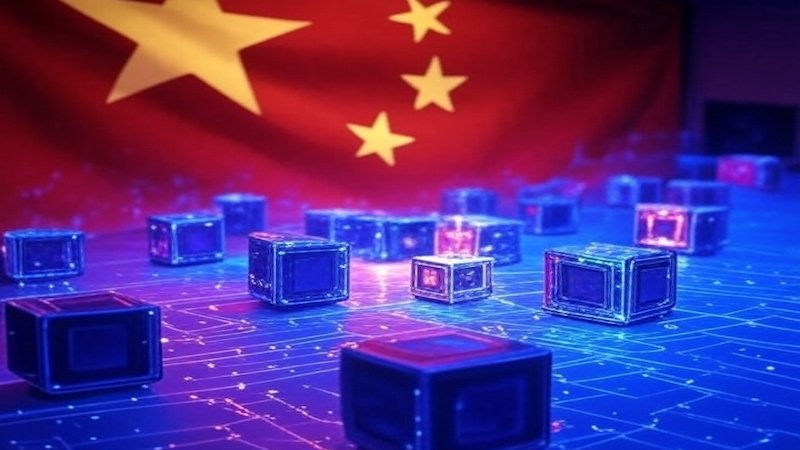By Shannon Vaughn
Introduction
(FPRI) — While international attention often centers on China’s latest foundation models or its constrained access to high-end artificial intelligence (AI) chips, these headlines obscure the broader architecture of China’s AI strategy. China is pursuing a dual-track approach that combines frontier model development with a coordinated effort to promote widespread diffusion (人工智能扩散) of AI technologies across sectors.
This strategy operates at two levels. Nationally, Beijing has launched top-down initiatives to embed AI into education, industrial planning, and public governance. Simultaneously, provincial and municipal governments are deploying bottom-up, localized incentives, to include compute vouchers, model subsidies, and talent attraction policies, to accelerate adoption and build out regional ecosystems.
Rather than focusing merely on technological breakthroughs, China’s approach emphasizes integration: ensuring that AI capabilities are not only developed, but also deployed across the real economy. Understanding this policy model and the mechanisms that support it is essential to evaluating China’s long-term trajectory in global AI competition.
Bottom-Up: The Provincial Race to Build an AI Ecosystem
Compute Vouchers (算力券)
Local governments across China, including Beijing, Shanghai, and Shenzhen, have begun issuing computing power vouchers, which subsidize the cost of renting computing time for AI startups. Voucher and are typically worth around US$140,000 to $200,000 but can go higher: Zhejiang (the home province of Deepseek) has offered to cover costs up to ¥8 million RMB (around US$1.1 million). Companies can redeem these vouchers for time in data centers to train or run new AI models, which helps lower the upfront costs for smaller AI startups.
Although compute vouchers are issued locally, their adoption was first encouraged at the national level. After a December 2023 meeting, the National Development and Reform Commission included computing power vouchers in its implementation guidance for the national Eastern Data, Western Computing (EDWC, 东数西算) initiative, which is constructing massive computing clusters across energy-abundant western China. EDWC primarily targets the supply side (building large pools of compute and greener power), while compute vouchers operate on the demand side by subsidizing firms’ ability to access those resources.
While compute vouchers reduce barriers to entry for smaller AI firms, their scale remains limited. These subsidies are typically sufficient to support the training of smaller, domain-specific models or to offset inference costs for startups. However, they are not designed to underwrite the enormous compute demands of training large-scale, general-purpose foundation models. China’s national champions continue to dominate access to advanced compute clusters, highlighting the difference between policies aimed at fostering broad ecosystem growth versus those targeting frontier breakthroughs.
Model Vouchers (模型券)
In 2024, many Chinese city and provincial governments began issuing model vouchers as well. Instead of subsidizing raw compute time (used to train new models), model vouchers help firms buy AI services. Model vouchers can subsidize large-scale access to an existing model via application programming interfaces (APIs), or they can subsidize the purchase of rights/licensing to a pre-trained model outright.
Companies can only buy access to foundation models that are registered with the Cyberspace Administration of China, in line with national State Administration for Market Regulation (国家市场监督管理总局). By lowering the price of buying model access or licenses, model vouchers make it easier for small and medium-sized enterprises to experiment without needing an in-house AI team or large compute budgets. This encourages broader diffusion of AI capabilities across the economy rather than concentrating AI use inside a few large tech firms.
Talent Incentives Across Provinces
Across China, local governments have become testing grounds for AI talent incentives that align with national priorities in scaling up China’s AI innovation ecosystem. While these housing subsidies and rent reductions have long been used in China to attract scientific talent, this attempt is new as it is being adapted specifically for AI.
In Shenzhen, one of China’s most successful tech hubs, the municipal government offers incentives aimed at both foreign and domestic AI professionals. The city offers housing subsidies, living allowances, and startup funding. In order to make residency easier for qualified foreign nationals with innovation potential, Shenzhen has streamlined visa processing, making it easier for certain individuals to begin working and living there.
Zhuhai, a city operating under the Greater Bay Area framework, is specifically targeting a younger demographic. Recent university graduates can receive free housing for their first year, a 70 percent rent reduction in the second year, and a 50 percent subsidy in the third. The city plans to offer 36,000 housing units under this program—demonstrating a long-term commitment to building a new generation of AI-capable workers.
In Shanghai’s Lin-gang Special Area, the new talent policies allow newcomers the ability to receive free accommodation, welcome packages, and rent-free startup spaces for up to three years. The city has also committed to building three thousand new talent apartments, which are designed to be rent-reduced for up to six years. Founders can also apply for up to six months of completely rent-free housing, demonstrating the city’s interest in developing grassroots innovation.
Top-Down: The Centralized Push to Embed AI Everywhere
National AI Curriculum Reform
The new AI curriculum launched by China’s Ministry of Education in spring 2025 marks a shift in how states can shape emerging technologies development. By embedding AI into the national curriculum and equipping schools with smart classrooms, China is building not just talent, but societal familiarity with algorithmic systems.
At the primary school level, students are introduced to basic programming logic and AI applications with the goal of sparking early interest. By senior high school, the curriculum shifts toward systems thinking, machine learning fundamentals, and innovation skills. This reform is supported by national teacher training programs and digital infrastructure platforms that standardize AI learning resources nationwide.
China’s university system has also expanded its AI offerings. More than five hundred universities now offer AI-related degree tracks ranging from core research to applied algorithms in medicine, law, and agriculture. Many of these programs are co-funded by the Ministry of Education and provincial governments, ensuring alignment between local workforce needs and national priorities.
A Holistic Strategy: Tying the Two Together
Many of China’s most consequential AI policies are not aimed at producing world-leading scientific breakthroughs or training the largest frontier models. Instead, they are designed to drive diffusion: the widespread adoption and integration of artificial intelligence into every corner of the Chinese economy and society. As FPRI Fellow Jeffrey Ding has argued, a nation’s ability to diffuse general-purpose technologies such as AI—across sectors, firms, and regions—may prove more decisive for long-term national power than frontier innovation alone.
China’s implementation of compute and model vouchers, paired with a national AI education curriculum, reflects this strategic emphasis. These tools lower the barriers for small- and medium-sized enterprises to access AI models and services, while simultaneously ensuring that students across the country gain basic AI literacy from an early age. Beijing’s local government makes this goal explicit in its model voucher application: to encourage adoption across industries such as “education, healthcare, culture, transportation, government affairs, industry, finance, marketing, justice, media, energy, film and television, gaming, and landscaping.”
This, however, is not a novel approach for China. Rather, it’s a proven industrial policy model repurposed for AI. For decades, China has used this formula: set a national strategic priority, then empower provinces and cities to compete through local subsidies and implementation flexibility. This approach has shaped the trajectory of the steel, solar, battery, and electric vehicle industries, often creating “local champions” through heavy subsidy competition. In the case of AI, compute and model vouchers represent the latest application of this old playbook to a new technological frontier. It is a strategy optimized for speed, scale, and system-wide integration—and one that foreign observers would be wise not to underestimate.
Constraints and Realities
Despite the ambition and sophistication of China’s AI incentive system, it is not without limitations. The most significant technical constraint remains access to advanced computing hardware, particularly high-end graphics processing units (GPUs) needed for training large-scale foundation models. such as those restricting access to NVIDIA’s A100 and H100 chips—have created a persistent bottleneck. Although China has made strides in developing domestic alternatives, these chips still lag in efficiency and scalability. As a result, many Chinese AI firms rely on workarounds, including distributed training architectures or lower-performance compute, which limits the speed and scale of frontier model development.
On the fiscal side, budgetary sustainability poses a second challenge. While compute and model vouchers, housing subsidies, and education investments are effective at stimulating diffusion, they require continuous and often escalating government support. Local governments, especially in inland or second-tier cities, may face pressure to reduce spending or reallocate funds, particularly if voucher programs fail to yield immediate economic returns. This raises questions about the long-term viability of some of China’s more aggressive subsidy schemes.
A final constraint lies in balancing AI development with national security and regulatory priorities. China’s cybersecurity laws, data localization requirements, and model registry system create friction for companies seeking to experiment freely or deploy generative models at scale. As the central government tightens controls over algorithm transparency, content filtering, and model registration, innovators must constantly navigate a shifting compliance landscape. These constraints reflect the Chinese Communist Party’s desire to maintain control over powerful technologies—but they also introduce friction that can slow the pace of market-driven AI innovation.
Risks and Opportunities for the United States
Risks
The United States faces a number of strategic risks if it fails to recognize and respond to China’s AI diffusion strategy. Chief among them is the risk of falling behind in long-term talent development. While China embeds AI education into its national curriculum from primary school onward, the United States continues to rely on a patchwork of voluntary initiatives, science, technology, engineering, and mathematics grants, and ad hoc partnerships. Without a systematic pipeline, the United States risks shortages not only in AI research talent but also in the skilled labor needed to adopt and apply AI across industries.
A second risk lies in the fragmented nature of US state-level AI policies. While some states are experimenting with tax incentives, digital infrastructure grants, or AI regulation, there is no unified framework to align state and federal goals. This lack of coherence could lead to duplication of efforts, wasted resources, or regulatory inconsistencies that slow down adoption. In addition, the United States must not overlook the importance of diffusion relative to invention. Much of the US policy discourse remains centered on model benchmarks and AI safety at the frontier. But China’s strategy builds economic and geopolitical leverage through widespread, normalized use.
A fourth and underappreciated risk is the vulnerability of the US AI supply chain. While US firms currently lead in GPU design, they remain dependent on foreign supply chains for advanced manufacturing and critical inputs, especially rare earth minerals, battery components, and advanced packaging. As competition for these resources intensifies, domestic bottlenecks could hinder the deployment of AI systems at scale.
In the military domain, China’s integration of civilian and defense AI development, often referred to as “military-civil fusion” (军民融合), poses another challenge. The People’s Liberation Army can directly draw on advancements in civilian large models, robotics, and data systems in ways that are more structurally difficult to accomplish under US civilian-military divisions.
Finally, the United States should be alert to China’s growing influence in shaping global AI norms and standards. Through active participation in organizations like the International Telecommunication Union, International Standards Organization, and regional standards bodies, China is increasingly shaping the technical definitions, ethical frameworks, and operational guidelines for emerging technologies—often in ways that reflect state-centric values.
Opportunities
The United States cannot and should not copy China’s diffusion model. But it can build one rooted in its own strengths: technical leadership, decentralized governance, and democratic values. By leveraging these advantages, the United States has the opportunity to remain a global leader in the responsible deployment of AI.
One promising pathway is to pilot targeted incentives such as AI service vouchers, local compute credits, and streamlined talent visa programs. These could lower barriers for early-stage adoption without resorting to heavy-handed state planning. Unlike China’s centralized approach, the United States can empower local experimentation, guided by federal strategy and supported by private-sector innovation.
To be clear, the United States already possesses considerable assets. Its private-sector–led ecosystem remains unmatched in its capacity to produce frontier models. But to close the gap between invention and diffusion, the United States must pursue complementary adoption policies that make AI tools widely accessible to small businesses, nonprofits, and regional governments.
A particularly underused lever is public-sector procurement. Federal and state governments can act as accelerators by:
- prioritizing AI solutions in high-impact public services such as healthcare, education, and infrastructure
- developing demonstration use cases that set the standard for private-sector replication
- providing clear guidance and incentives for regulated industries to adopt trustworthy, responsible AI.
By modernizing procurement rules and exercising the government’s power of the purse, the United States can help shape domestic AI markets while reinforcing democratic norms of transparency, privacy, and fairness.
Finally, the United States must double down on AI literacy and workforce retraining. Investing in K-12 and community college AI curricula, expanding adult upskilling programs, and building robust federal partnerships for applied education will ensure that AI benefits are not confined to a technical elite. Diffusion is ultimately about people, not just code—and this is a race the United States can still win.
Conclusion
China’s AI strategy is not a single monolith but a dual-track system, where top-down national planning interlocks with bottom-up provincial experimentation. Model vouchers in Hangzhou, housing incentives in Zhuhai, and AI curriculum reforms in Beijing are all manifestations of a broader national goal: to embed artificial intelligence into the everyday fabric of Chinese economic, social, and political life. From cloud infrastructure to primary school classrooms, China is building an ecosystem where AI is not just invented—it is adopted, deployed, and normalized.
For policymakers in the United States and allied democracies, the lesson is clear: AI competition with China requires more than breakthroughs in large language models. It requires designing systems—of education, incentives, infrastructure, and workforce support—that make AI usable and valuable across society. In this era of AI, the power to diffuse may matter as much as the power to invent. Understanding this distinction may prove essential to maintaining global leadership in the decades ahead.
The author would like to thank Charlie Alaimo and Avery Sullivan for their contributions to this article.
- About the author: Shannon Vaughn is a Non-Resident Fellow with the Asia Program at the Foreign Policy Research Institute (FPRI) and the General Manager of Virtru Federal, a data privacy company headquartered in Washington, DC.
- Source: This article was published by FPRI











































